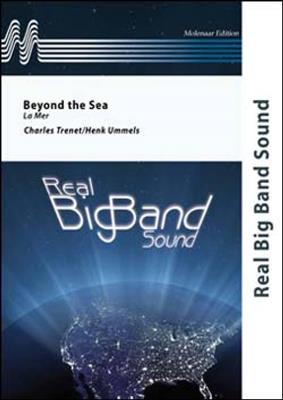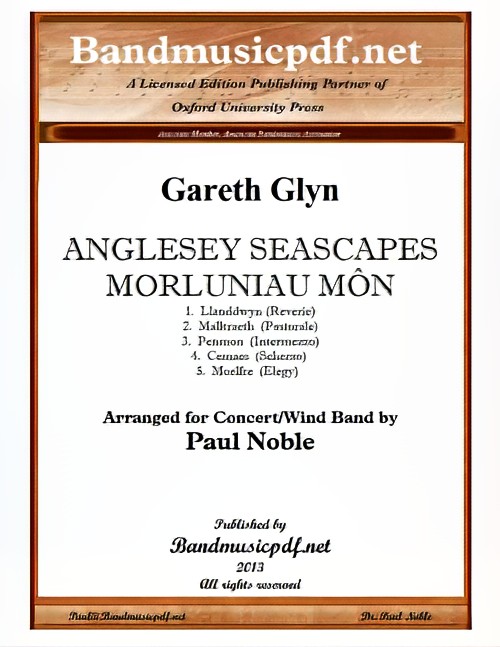Results
-
 £204.99
£204.99Out to Sea and The Shark Cage Fugue (from Jaws) - John Williams
Referring to the 1975 blockbuster Jaws, director Steven Spielberg states that John Williams' music was clearly responsible for half the success of the movie. This suite features two of the signature musical sequences. In Out toSea, the trio of shark hunters led by police chief Martin Brody (played by Roy Scheider) heads into open water to find the menacing beast. This is followed by the Shark Cage Fugue, a classically inspired and sophisticatedaccompaniment to a tense underwater scene in which Hooper (portrayed by Richard Dreyfuss) comes face-to-face with the great white in an all-too-fragile suspended cage. Performance time - ca. 3:40
Estimated dispatch 7-14 working days
-
 £64.99
£64.99Under The Sea
Estimated dispatch 7-14 working days
-
 £86.70
£86.70 -
£64.40
Beyond the Sea
Estimated dispatch 7-14 working days
-
 £84.99
£84.99Ponyo on the Cliff by the Sea - Joe Hisaishi
New Sounds in Concert Band Series(NSB). Main songs from Studio Ghibli's movie Studio Ghibli's movie Duration: approx.4'50" Arranged by Hideaki Miura
Estimated dispatch 7-14 working days
-
 £244.99
£244.99Voyage au Centre de la Terre (Journey to the Centre of the Earth) (Concert Band - Score and Parts) - Janssen, Harrie
This composition was based on the world-famous novel by the French author Jules Verne. This novel describes the attempt to reach the centre of the earth. The descent of the crater of the volcano called Snaeffels, situated in Iceland, marks the beginning of this voyage to the sublunary world. The German geologist, professor Lidenbrock, is accompanied on this trip by his nephew Axel and an Icelandic guide named Hans. The last mentioned will be helpful in many occasions.Dark colours & mist: The composer tried in this single work to give a musical expression to various significant moments from this novel. In the introduction he sketches an image of the dismal ambience on the island by using dark colors. Rising fragments of mist reveal the flanks of the monumental mountain Scataris. The composer tries to catch this image in a majestic and broad chorale.Away from Iceland: Subsequently the ostinato rhythmicity and virtuosity represent the hectic descent of the crater of the volcano. The party descends ever more and more and travels south, away from Iceland. On the way, they see all kinds of rock formations, fossils and minerals. At a depth of thirty hours walking distance, at about 150 kilometres below the surface, they reach a sub terrestrial sea which is called the Lidenbrock sea.Genuine eruption of sounds: Strange electric manifestations and unpredictable weather conditions accompany this singular phenomenon. An orchestral tutti-episode expresses this impression musically. On a make-shift raft, the party continues its voyage, heading to the south coast of this huge sea. Once ashore, an enormous rock obstructs the passage. The blowing up of this obstacle unleashes a genuine eruption of sounds in the orchestration.Spat out by the volcano: But the explosion has an unforeseen side effect. The sea - travellers and raft included - is sucked upwards into a dark hole. Again, our heroes are accompanied on their involuntary voyage, while left to fend for themselves, by an ever increasing ostinato rhythmicity. Before an eruption can destroy the raft, the threesome manages to escape and climb up through a cave towards the daylight. They seem to be spat out by the Stromboli volcano on the island of Sicily, far from home. The composition ends with triumphant sounds that represent the scientific triumph of these adventurers.Duration: 22.00
Estimated dispatch 7-14 working days
-
 £199.95
£199.95STORM SURGE An Elemental Portrait for Concert Band (Prestige Concert Band - Score and Parts) - Clarke, Nigel
Storm Surge is a musical representation of the devastating North Sea storm surge (in Dutch, Watersnoodramp) of 1953. The surge left 2551 dead, 1836 people from the Netherlands alone, together with fatalities in Scotland, England and West Flanders. Storm Surge starts off with calm waters, while we hear the steadily growing sounds of the wind and sea. A specially commissioned poem, written by Martin Westlake, spoken over these sounds, warns of the dangers of ignoring the storm. Slowly, the storm starts to take hold and the sea begins to swell. The violence of the storm then erupts, but before it reaches its climax, the Dutch National Anthem gives a sense of the calm in the eye of the storm. It then returns to the storm surge and depicts the sea breaking through and ravaging the coastline. Eventually the storm surge recedes until a lone trumpet is left quoting broken fragments of the Anthem. The work closes with a calm breeze mournfully revealing the devastation left behind by this natural disaster.
Estimated dispatch 7-14 working days
-
 £37.95
£37.95STORM SURGE An Elemental Portrait for Concert Band (Prestige Concert Band Score inc. Sound Design CD) - Clarke, Nigel
Storm Surge is a musical representation of the devastating North Sea storm surge (in Dutch, Watersnoodramp) of 1953. The surge left 2551 dead, 1836 people from the Netherlands alone, together with fatalities in Scotland, England and West Flanders. Storm Surge starts off with calm waters, while we hear the steadily growing sounds of the wind and sea. A specially commissioned poem, written by Martin Westlake, spoken over these sounds, warns of the dangers of ignoring the storm. Slowly, the storm starts to take hold and the sea begins to swell. The violence of the storm then erupts, but before it reaches its climax, the Dutch National Anthem gives a sense of the calm in the eye of the storm. It then returns to the storm surge and depicts the sea breaking through and ravaging the coastline. Eventually the storm surge recedes until a lone trumpet is left quoting broken fragments of the Anthem. The work closes with a calm breeze mournfully revealing the devastation left behind by this natural disaster.
Estimated dispatch 7-14 working days
-
 £244.99
£244.99Journey to the Centre of the Earth - Harrie Janssen
This composition was based on the world-famous novel by the French author Jules Verne. This novel describes the attempt to reach the centre of the earth. The descent of the crater of the volcano called Snaeffels, situated in Iceland, marks thebeginning of this voyage to the sublunary world. The German geologist, professor Lidenbrock, is accompanied on this trip by his nephew Axel and an Icelandic guide named Hans. The last mentioned will be helpful in many occasions. Dark colors & mist The composer tried in this single work to give a musical expression to various significant moments from this novel. In the introduction he sketches an image of the dismal ambience on the island by using dark colors. Risingfragments of mist reveal the flanks of the monumental mountain Scataris. The composer tries to catch this image in a majestic and broad chorale. Away from Iceland Subsequently the ostinato rhythmicity and virtuosity representthe hectic descent of the crater of the volcano. The party descends ever more and more and travels south, away from Iceland. On the way, they see all kinds of rock formations, fossils and minerals. At a depth of thirty hours walking distance, atabout 150 kilometers below the surface, they reach a sub terrestrial sea which is called the Lidenbrock sea. Genuine eruption of sounds Strange electric manifestations and unpredictable weather conditions accompany thissingular phenomenon. An orchestral tutti-episode expresses this impression musically. On a make-shift raft, the party continues its voyage, heading to the south coast of this huge sea. Once ashore, an enormous rock obstructs the passage. The blowingup of this obstacle unleashes a genuine eruption of sounds in the orchestration. Spat out by the volcano But the explosion has an unforeseen side effect. The sea - travelers and raft included - is sucked upwards into a dark hole.Again, our heroes are accompanied on their involuntary voyage, while left to fend for themselves, by an ever increasing ostinato rhythmicity. Before an irruption can destroy the raft, the threesome manages to escape and climb up through acave towards the daylight. They seem to be spat out by the Stromboli volcano on the island of Sicily, far from home. The composition ends with triumphant sounds that represent the scientific triumph of these adventurers.
Estimated dispatch 7-14 working days
-
 £240.00
£240.00Anglesey Seascapes (Concert Band - Score and Parts) - Glyn, Gareth - Noble, Paul
Gareth Glyn lives on the island of Anglesey, where the encircling sea has always been indivisible from the mythology, history and everyday life and work of its people. This cycle of short miniatures, in a light music vein, seeks to represent various aspects of the sea as seen from five vantagepoints around the coast of Anglesey. The whole work is bound together by recurring musical motifs which change their character according to the prevailing mood. 1. Llanddwyn (Reverie): Island of the Welsh patron saint of lovers, Dwynwen, whose marriage to Maelon was never to be, and who dedicated her life to God. 2. Malltraeth (Pastorale): A brisk walk along Cob Malltraeth, a high dyke built to keep out the sea. 3. Penmon (Intermezzo): From a vantage point by the sacred priory of St Seiriol, old sailing ships and modern yachts can be seen scudding by in Regatta week. 4. Cemaes (Scherzo): The bustle of children's play and donkey-rides on the beach in midsummer. 5. Moelfre (Elegy): In remembrance of innumerable souls lost in shipwrecks off this coast, including the Royal Charter with its loss of 452 lives.
Estimated dispatch 7-14 working days
